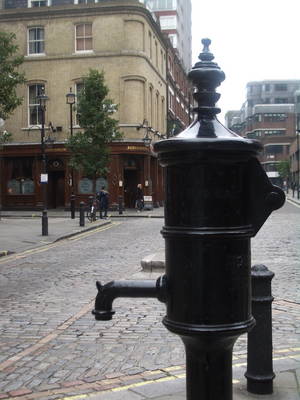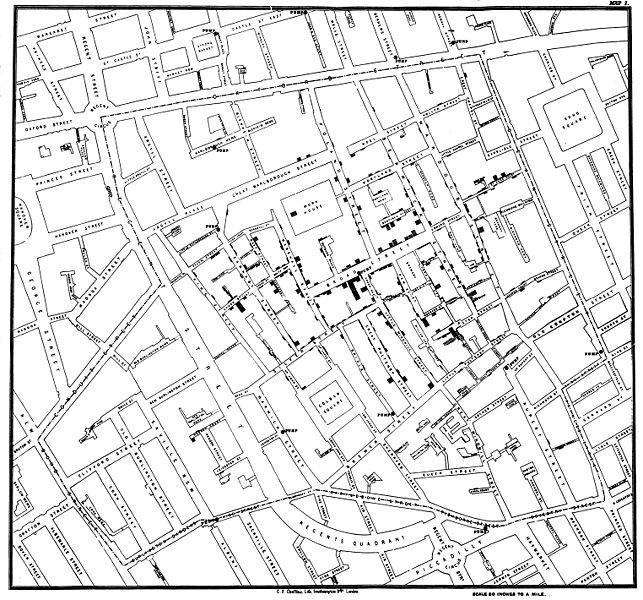The Legacy of John Snow
Interview with
Chris Smith spoke to medical historian and Wellcome Trust Engagement fellow Richard Barnett, from the Sick City Project, about why we're celebrating the 200th anniversary of the birth of the epidemiologist John Snow. He started by asking what conditions were like in London in John Snow's time, back in the mid-19th century.
Richard - If one wanted to pick one word to describe London in the mid-19th century, one would have to go for 'filthy' I think. This is an enormous city, it's a wealthy city, it's very, very powerful city, it's the headquarters of one of the greatest empire, certainly one of the largest empires the world has ever seen.
But at the same time, it's serviced by a sewage system and a system for supplying freshwater that hasn't really changed since medieval times. Most houses, well into the 1820s, 1830s, still have an old-fashioned cesspit in the cellar, so you put all of your excrement in a hole in the ground. Once a month, somebody comes along, digs it out, takes it off to the countryside, and spreads it on the fields. From the 1820s and 1830s, water closets start to become more popular. As we all know, if you have a lavatory in your house, you need two things. Firstly, you need a pipe bringing freshwater into the house, but you also need a pipe taking all the waste out of the house. And this is the crucial problem. There's no kind of central state run sewage disposal system at this time. What you have is a network of short sewers that simply pour all of these waste into the Thames and the Thames is a tidal reverse so it goes back and forth, twice a day, stirring all this up into the most incredibly disgusting, horrible, smelly kind of mess.
Chris - But also equally, when people are trying to cope with the fact there are no sewers and they've got lots of this stuff building up in the bottom of their house. Then if it overflows, there's going to be unpleasantness in the house, so they're going to take steps for that not to happen, and they're presumably going to empty this stuff before that happens and they're going to head to the street, aren't they?
Richard - That's not so much a problem by the 19th century. From a modern perspective, the major problem that this brings to light is the way in which drinking water is being drawn from exactly the same place that everybody is getting rid of their sewage. So, in modern terms, that's the perfect breeding ground for a kind of faecal-oral cycle of contamination. But the major concern for doctors at this time, is smell. The basic idea is that any kind of rotting generates noxious vapours known as miasmas. These rise into the air, they blow around in the air and if you breath them in, you will end up developing a filth disease like cholera or typhoid.
Chris - So, John Snow is operating in this environment where the prevailing theory is, disease comes in the form of airborne smells, malodours, miasma and yet, he connects that there is localised outbreaks of disease associated with certain environments. So, he's sort of pinning things down to an environment rather than just a generalised smell.
Richard - Well, the heroic myth of John Snow is generally based around this  heroic moment that took place on the 8th of September 1854. First thing that morning, a party of men approached a communal water pump on what is then Broad Street. It's now Broadwick Street in Soho and they take the handle off the pump.
heroic moment that took place on the 8th of September 1854. First thing that morning, a party of men approached a communal water pump on what is then Broad Street. It's now Broadwick Street in Soho and they take the handle off the pump.
Snow through epidemiological work, through some extremely brilliant insights has come to the conclusion that water from this pump is responsible for a terrible cholera epidemic which has killed about 500 people in Soho over the previous week. From the 1930s, a heroic myth has been woven around this story and there are really sort of three claims that this myth makes. Firstly, that Snow discovered the cause of cholera which he himself in his writings was very clear that he hadn't. Secondly, that he brought the epidemic to an end by removing the handle which again, he in his writings is very clear that he didn't and finally, that in making this argument, he revolutionised the ways in which his contemporaries thought about infectious disease which again, I'm afraid to say, he didn't.
Chris - So, why did it get so celebrated, but not until maybe 100 years almost after he died?
Richard - The change really comes. In 1936, when an American epidemiologist re-publishes Snow's 1855 pamphlet on the mode of communication of cholera where he sets out some remarkable epidemiological evidence for this conclusion that cholera is transmitted by water. Now, if you look at the status of epidemiology at that time, it's a comparatively low status profession. One of the things that this professor was trying to do was to create, if you like, a heroic founding father, a kind of foundational story for epidemiology and in the process, raises its intellectual status, but also, it's social status as a profession.
Chris - Rather shame to be eroding that, but I mean, nonetheless, it's a good story in the telling, isn't it? Well, I mean, what happened when John Snow's famous pump did to have the handle taken off? What was the outcome then?
Richard - Well, as Snow says in his pamphlet, cases of cholera were sharply declining in the days before the pump handle was removed and they didn't stop immediately as soon as it was taken away. So, the removal of the pump handle was really sort of symbolic. It was the local parish authority, showing that they'd accepted his ideas, whether or not it had any practical impact.
Chris - So, Snow gets the pump disabled, he has got some very interesting data. So, what does he do with it?
Richard - Well, the reason that epidemiologists are interested in celebrating Snow is because of two - as he called them natural experiments that he carried out during the 1854 Soho outbreak. The first of these was a detailed, almost forensic epidemiological study of the outbreak in Soho, the one that was clustered around the Broad Street pump and he finds one very striking case that's often referred to as the Hampstead widow.
A woman called Susannah Eley had lived in the area for most of her life, but she'd retired up to Hampstead. But somehow, she'd got a taste for the water from the Broad Street pump. Heaven knows what this water must have tasted like, but she was very, very keen on it. So, her relatives would send barrells of this water up the hill to Hampstead. Now, she suffered cholera, she died of cholera. Nobody else in Hampstead at that time suffered from the disease, so clearly, this was an isolated outbreak and Snow was able to link it directly to the consumption of water from the Broad Street pump.
 He also collected a great deal of data about death rates in and around the Broad Street pump. He then maps them onto a map of Soho, using a rather elegant sort of bar chart system. This is sometimes referred to as the ghost map and this provides a really striking visual demonstration of the fact that cholera cases cluster very obviously around the Broad Street pump. Now, this is a really, really striking correlation. It doesn't demonstrate causation.
He also collected a great deal of data about death rates in and around the Broad Street pump. He then maps them onto a map of Soho, using a rather elegant sort of bar chart system. This is sometimes referred to as the ghost map and this provides a really striking visual demonstration of the fact that cholera cases cluster very obviously around the Broad Street pump. Now, this is a really, really striking correlation. It doesn't demonstrate causation.
So Snow's second natural experiment is to study to two water companies who supplied water to South London. One of these companies, the Southwark and Vauxhall gets its water from Battersea Park. That's a stretch of the river that in the 1850s is very heavily polluted and very, very dirty. The other company, the Lambeth has waterworks up at Thames Ditton. The water is recognised to be much, much purer, there's much less sewage in it. So, when Snow has finally finished his study, he discovers that people who are getting their drinking water from lower down the Thames where it's much more polluted are about 10 times more likely to die of cholera.
Chris - That's pretty compelling, isn't it? I mean, that would stand up to scrutiny today. It would be so much of journal for an epidemiological study. I mean, this is pretty amazing as a piece of work that someone was doing so early on.
Richard - Absolutely. I mean, mathematically, it's very, very impressive and again, retrospectively to our modern eyes, it's an extremely impressive piece of work especially given that this is basically one GP working in Soho and doing all of this stuff in his spare time, while he's trying professionally to deal with the cholera epidemic amongst his patients.
- Previous Fighting Cholera Today
- Next Tracking the Global Spread of Cholera









Comments
Add a comment